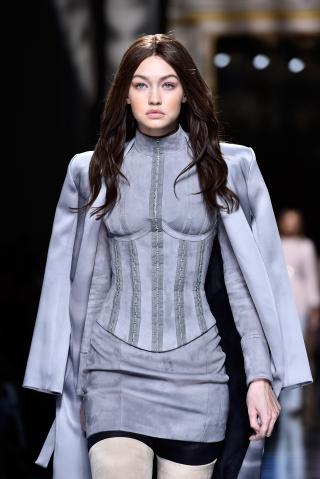My month in Kim Kardashian’s korset
written for The Times, 9th June 2016
I’m standing in the lobby of the Library of Congress in Washington DC, stripped down to my underwear. I have come here on a research trip not thinking that my unusual underwear might get me into trouble. I’ve spent 30 days winched into a “waist trainer”, or modern corset, hidden under my clothes, but this contraption of latex and steel has set off the metal detectors. The man with the gun is not amused. Who knew that my quest for a slimmer waist might be a bad idea in the land of routine concealed weapon searches?
You don’t need to follow the fashion pages to know that the corset is making a comeback. In the US, Kim Kardashian and her sisters have credited their shapes to these belly-cages; here in the UK, they are endorsed by such icons of female liberation as Amy Childs from The Only Way is Essex and the “Cheltenham boob-flasher” Jessica Hayes, of Desperate Scousewives.
Things have changed since Victorian times, of course. Now, we’re told, the waist trainer is about health: improved posture, increased circulation, even athletic fitness. The problem is that hawkers of corsets a century ago were peddling the very same pseudo-science, as I was reminded by a brief visit to the Victoria and Albert’s exhibition Undressed: A Brief History of Underwear.
The S-bend corset, an Edwardian innovation, was billed as “the health corset”. Instead, it crushed the groin, forcing the pelvis backwards and selling young women an unnatural figure in exchange for the mobility of an arthritic 83-year-old. Flick through the emancipatory promises of their 21st-century descendants, and it feels like we’re reversing a century of fragile progress.
Yet the truth is I’ve been darkly fascinated by the promise of the corset since childhood. At which point, I never worried I’d really need one. Amid an adolescence of nerdery, my feminine trump card was always my effortlessly skinny waist.
While my teenage friends succumbed to an epidemic of eating disorders, that pitfall never seemed to touch me — my metabolism was so high that I could stuff my face with chips and not worry for a moment about my figure. As a voracious reader, I’d imbibed some of this from the Victorians direct: “When I was married”, says Mother in Laura Ingalls Wilder’s Little Town on the Parire, “your Pa could span my waist with his hands.” If they’d managed it in the books, I could manage it too.
For years it came easily. With studied casualness, I’d stroll away from the school canteen and drape my hands around my waist, noting the grimace on my peers’ faces as my thumb and fingers enclosed both front and back without effort. At university, my best friend confided that her boyfriend had vetoed me from their fantasy threesome list on the grounds that I was far too scrawny for fun (“her hip bone might take your eye out.”) I was delighted, for many reasons (and I told myself that she was fat, anyway).
However, a funny thing happens as you head towards 30. (Readers closer to 60, feel free to groan now.) With a new, slower metabolism, my body has become that of a stranger, co-opted by a parasitic growth. The poet Delmore Schwartz writes of “the heavy bear that goes with me”; like the feminist Susan Bordo, who draws from Schwartz’ poem in her book on anorexia, Unbearable Weight, I heard Schwartz’ words and saw in the mirror my own alien, lumbering flesh which “moves where I move, distorting my gesture.” Over the last two years I’ve had to buy a whole new wardrobe. I’m learning, like a teenager all over again, to style myself anew – hiding new bulges, using the good curves to distract from the bad ones. It’s not just my body that feels like a false reflection in the mirror, but the new costumes I wear above it. If I can’t wear my favourite wrap dresses again, I won’t be me. Or at least, I won’t have the right armour to take on the world.
So, à la Kim, could I press, primp and constrain my body into something I recognised as mine again? I was certainly prepared to try, and damn the feminist hypocrisy (as real women we are, said Simone de Beauvoir “half victims, half accomplices, like everyone else.”) But would it work?
Contemporary waist trainers promise a visible reduction in the waistline after three weeks of use, assuming you wear them for a least six to eight hours a day. Designed to fit under clothes, they will also offer an instant “lift”, although I wouldn’t recommend wearing them out in public until you’re used to them. Especially if you’re trying to relax.
Ten days into my trial, a flirtatious male journalist took me to a fashionable tapas spot in Spitalfields. An hour in, I decided the food was a better bet than he was, excused myself, and whipped the wretched thing off in the loo. I returned, confessed and started munching down on the goodies without the slightest regret, while he stared with an unconcealed fascination at the steel hooks and neon blue spandex now peeking out of my handbag.
Certainly, food is a problem. The actress Lily James regularly jokes on the interview circuit about the corset she wore in Disney’s recent Cinderella: “If you ate food it didn’t really digest properly and I’d be burping all afternoon. I’d have soup so that I could still eat but it wouldn’t get stuck.” James is telling the truth. It’s not just food for which there’s no space in the gullet: catch the slightest air bubble in the squashed digestive system and it’s pushed up and out — or, err, downwards. One glass of champagne at a theatre gala, and I was burping little hiccups of boozy sunshine all evening. If only all my other belches had been so pleasant.
If you really do want a quick fix, a waist trainer works. “You look fantastic!” squealed my dinner party guests as I opened the door, my fixed grin masking the chaos that had ensued as I tried to rush through the pre-party Tesco run in the lung-lacerating monstrosity. Now, all dressed up, I felt a bit like Cinderella myself. (“Have you lost weight?” they trilled. I saved the striptease for later.)
I felt elegant too, but in that longed-for elegance, I felt something far more darkly feminine: fragility. Wear a corset for even a day and your centre of gravity rises — tottering, my head was light, my breathing shallow. Pair it with that other engine of the beauty myth, high heels, and a gust of wind will blow you away. When I sat down to try to work, basic vocabulary dropped out of my memory, as I groped for familiar facts in a haze of headache. I lost an afternoon of study — imagine, then, how much Victorian women might have achieved if they hadn’t been wasting all their energy trying to breathe.
No wonder, I decide, that Victoriana is full of all those consumptive heroines and dashing doctors. It must have been pretty easy to impress as a heroic doctor at an 1890s gathering: catch a woman swooning, have the genius to unlace her corset, and suddenly you’re a miracle worker.
Of course, nowadays, it’s not usually posh young women who are sold a dream of bodily perfection for the cost of a few precious whalebones. Ann Chery, the manufacturer that dominates the market, is sold under a range of brands internationally. In the UK, they are aimed at working-class white women; in the US, Kardashian’s rapper friend PreMadonna exclusively markets the corsets that Kardashian endorses to African-American women.
(As the Washington Post columnist Sally Kohn noted at the time, Kardashian’s notorious 2014 #BreakTheInternet photoshoot directly replicated Jean Paul Goude’s 1976 Jungle Fever shot of the black model Carolina Beaumont; Kardashian, buttocks and all, has a long history of trying to represent herself as a white-skinned black icon.)
The starting size for Ann Chery waist trainers is for women who already measure a 23-24in waist; ie it is aimed at a girl with a tiny waist who wants to make it even smaller. It’s hard to imagine anyone who fits that description who isn’t a teenager with an eating disorder.
So I tell myself, every day for 30 days, that Ann Chery is an awful and exploitative company. Yet of course, by the end I’m still a little bit addicted. There’s something seductive about a newly discovered ultra-feminine posture, although it’s impossible to sit straight on a theatre bench in my day job as a critic for The Times. (I leave the contraption at home to sit through four and a half hours of Shakespeare in Dutch at the Barbican Centre, though it feels oddly appropriate for six hours of Götterdämmerung two weeks later.)
I lose two inches on my waist, but gain another inch on my hips (it has to go somewhere). The net loss is almost certainly because I’m incapable of eating properly — starving my inner bear to slim my outer one. So by the end of the month, I’m sveltely self-satisfied, and nonetheless filled to the brim with self-loathing. I’m even tempted to burn the darned thing, but with so much synthetic fabric in play, I fear my eco-feminist sisters wouldn’t approve. So I rip it off and hit the chocolate cake. The corset sits at the back of my wardrobe, judging me. And it stays sitting there. And as long as it sits there, in its own way, it remains just as tempting as the chocolate cake.







